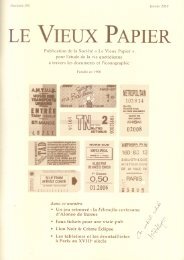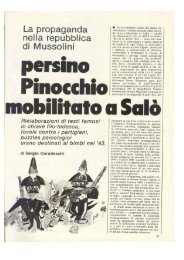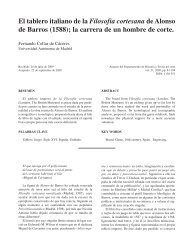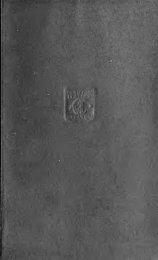Board games from the city of Vijayanagara (Hampi ... - Gioco dell'Oca.
Board games from the city of Vijayanagara (Hampi ... - Gioco dell'Oca.
Board games from the city of Vijayanagara (Hampi ... - Gioco dell'Oca.
Create successful ePaper yourself
Turn your PDF publications into a flip-book with our unique Google optimized e-Paper software.
26<br />
B OARD G AME S TUDIES 6, 2003<br />
The study <strong>of</strong> board <strong>games</strong> at <strong>Hampi</strong> yield rich anthropological, historical and sociological<br />
information, but many <strong>of</strong> <strong>the</strong>se age-old board <strong>games</strong> are disappearing <strong>from</strong> regular<br />
daily life <strong>of</strong> <strong>the</strong> local people. It has now become indispensable to document and<br />
preserve as much information as possible.<br />
With this in mind, <strong>the</strong> present paper has been drafted to highlight <strong>the</strong> board <strong>games</strong><br />
played during <strong>the</strong> pre-modern era by <strong>the</strong> people <strong>of</strong> <strong>Vijayanagara</strong>, and my survey includes<br />
and illustrates <strong>the</strong> details <strong>of</strong> all available board <strong>games</strong>, <strong>the</strong>ir contents, and rules and how<br />
<strong>the</strong>y are played. It also illustrates both living <strong>games</strong> and <strong>games</strong> not in practice, wherever<br />
possible living <strong>games</strong> are directly recorded <strong>from</strong> individuals by personal interview,<br />
observation, and over-<strong>the</strong>-board demonstration.<br />
In this paper I will follow Murray’s classification <strong>of</strong> board <strong>games</strong> (as in Murray 1952).<br />
At <strong>Hampi</strong> we find:<br />
1. Games <strong>of</strong> alignment<br />
2. Hunt <strong>games</strong><br />
• On triangular board<br />
• On square board<br />
• Solitaire<br />
3. Mancala <strong>games</strong><br />
4. Chess<br />
5. Pachisi or Chaupat<br />
6. Single-track <strong>games</strong><br />
1. Games <strong>of</strong> alignment<br />
Local names: Paggada ata, Mooru mane ata (in Kannada), Char pur (in Telugu)<br />
Locations: 1. Hemakuta Jaina temples, 2. under <strong>the</strong> boulders, 3. underground temple,<br />
4. Hazara Rama temple, 5. Vitthala temple, 6. Pattabhi Rama temple, 7. practically<br />
everywhere<br />
Population groups: Still played by masses (also agricultural class) as pastime.<br />
Literary sources: Goparaju 1398; Nanjunda 1500b<br />
Fig. 1<br />
This game is drawn on <strong>the</strong> floor <strong>of</strong> <strong>the</strong> outer mandapa<br />
<strong>of</strong> Hazara Rama temple. This game <strong>of</strong> alignment<br />
is played only by children <strong>of</strong> 5-7 years <strong>of</strong> age. It is<br />
termed a simpler game and is for beginners.<br />
Rules:<br />
Two players, each with three counters – pebbles or<br />
marbles – place a counter one at a time onto one <strong>of</strong> <strong>the</strong><br />
intersection <strong>of</strong> two lines (which is one <strong>of</strong> <strong>the</strong> nine<br />
points), during alternate turns <strong>of</strong> play. Each player is<br />
attempting to make an orthogonal row before <strong>the</strong> o<strong>the</strong>r<br />
player does this. When all <strong>the</strong> counters have been<br />
placed, <strong>the</strong> game continues, and during alternative Fig. 1 Mooru mane ata







